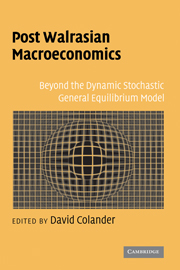Book contents
- Frontmatter
- Contents
- List of Contributors
- Foreword by Alan Kirman
- Introduction
- PART I WHERE WE ARE IN MACRO AND HOW WE GOT THERE
- PART II EDGING AWAY FROM THE DSGE MODEL
- 5 Social Interactions and Macroeconomics
- 6 Macroeconomics and Model Uncertainty
- 7 Restricted Perceptions Equilibria and Learning in Macroeconomics
- 8 Not More So: Some Concepts Outside the DSGE Framework
- PART III LEAPING AWAY FROM THE DSGE MODEL
- PART IV LETTING THE DATA GUIDE THEORY
- PART V POLICY IMPLICATIONS
- Bibliography
- Index
7 - Restricted Perceptions Equilibria and Learning in Macroeconomics
Published online by Cambridge University Press: 02 December 2009
- Frontmatter
- Contents
- List of Contributors
- Foreword by Alan Kirman
- Introduction
- PART I WHERE WE ARE IN MACRO AND HOW WE GOT THERE
- PART II EDGING AWAY FROM THE DSGE MODEL
- 5 Social Interactions and Macroeconomics
- 6 Macroeconomics and Model Uncertainty
- 7 Restricted Perceptions Equilibria and Learning in Macroeconomics
- 8 Not More So: Some Concepts Outside the DSGE Framework
- PART III LEAPING AWAY FROM THE DSGE MODEL
- PART IV LETTING THE DATA GUIDE THEORY
- PART V POLICY IMPLICATIONS
- Bibliography
- Index
Summary
Since the 1970s, Rational Expectations (RE) has become the dominant paradigm in macroeconomics. One reason for its popularity is the consistency it imposes between beliefs and outcomes. Under RE agents' subjective probability, distribution coincides with the true distribution for the economy. Not surprisingly, a large literature objects to RE on the grounds that it requires agents to possess unreasonable information and cognitive abilities. Instead many researchers (e.g. Evans and Honkapohja [2001]) replace RE with an econometric forecasting model and ask under what conditions the forecasts converge to RE. The validity of RE is not just theoretical curiosa, Branch (2004) and Carroll (2003) demonstrate persistent heterogeneity in survey data on inflation expectations. Such phenomena cannot be explained by RE models. Papers such as Brock and Hommes (1997) generate heterogeneity by assuming agents make conscious choices between costly predictor functions, thereby, hypothesizing that deviations from rationality come from a weighing of benefits and costs.
These drawbacks, though, do not imply that there are no valid insights from the RE approach. In Muth's original formulation of the rational expectations hypothesis, he advocated for subjective expectations that coincide with the true distribution. His argument rested on the joint determination of beliefs and the economy. This is the self-referential feature of most dynamic models: the economy depends on expectations that should depend on the structure of the economy. If agents' subjective beliefs did not take account of the economic structure, then their forecasts would consistently perform badly.
- Type
- Chapter
- Information
- Post Walrasian MacroeconomicsBeyond the Dynamic Stochastic General Equilibrium Model, pp. 135 - 160Publisher: Cambridge University PressPrint publication year: 2006
- 14
- Cited by



